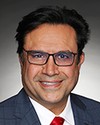Absolutely, and, yes, Santanna had to step out. She actually had to get to another space to talk about this exact issue.
When it comes to engaging residents and medical students in more rural areas, ultimately if you look at it from the perspective of “as early up in the pipeline as possible”, of course, the best way to recruit people to a region is to recruit the people from that region, so the opportunities for people from rural locations to matriculate into medical school has to be looked at.
From the perspective of the federal government, that's about lowering the barrier in terms of cost, in terms of opportunity for people from that region to get the required education to be able to apply and then get in. We've seen medical school admissions start to look at this, but upstream there need to be much more work on this as well.
In terms of getting current residents in these spaces, ultimately it's about investing in having the education available in those spaces.
Santanna mentioned one of the big things about rural medicine is they are quite often playing short-handed in that they don't have the same resources. For example, I did one of my clinical rotations up in Wiarton, which is not too rural compared to places in northern Ontario, but there were still decisions we had to make in management where we didn't, for example, have a CT scanner that we could use immediately, or all of the things in blood work that we can normally do.
Making these places more attractive for physicians of different stripes by making sure these resources are available to them is one piece, and also partnering with the medical schools and investing in more spots maybe in those places would be one fantastic thing to do as well. Ultimately, they are trying to allocate spots in the residencies the best that can based on the regions that they occupy. At the end of the day, we only have so many medical schools and only fewer spots.
Those are a couple of things we can do.





